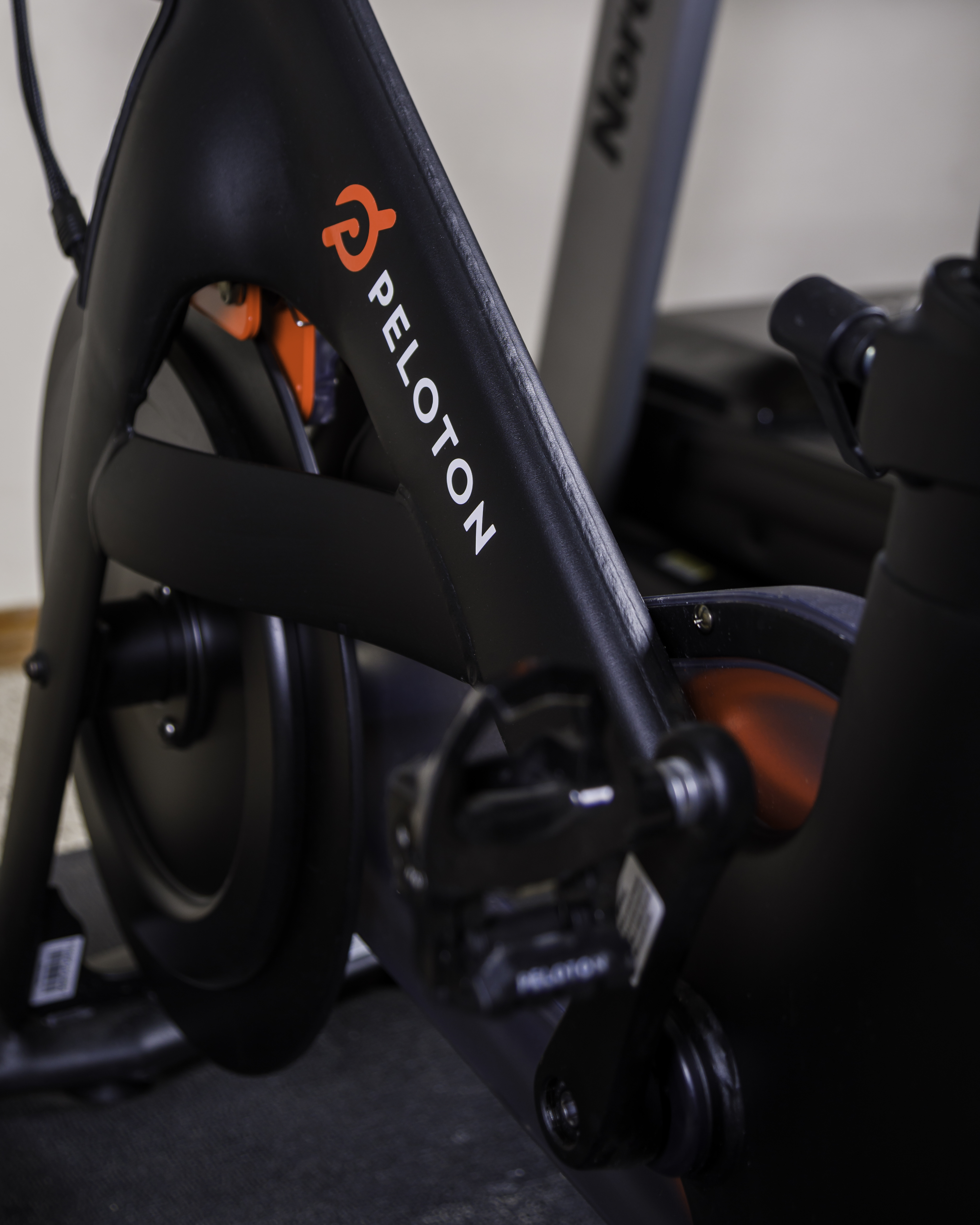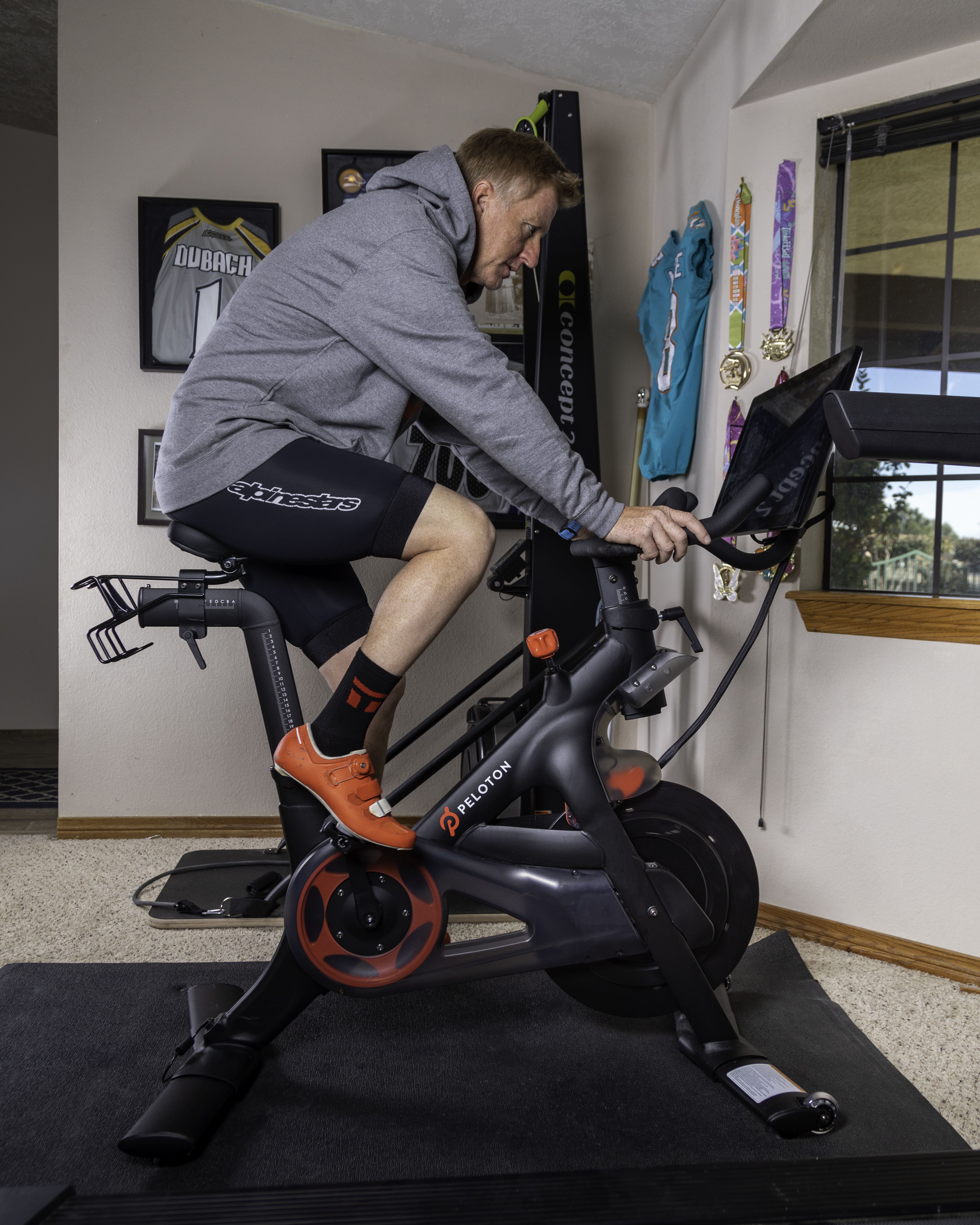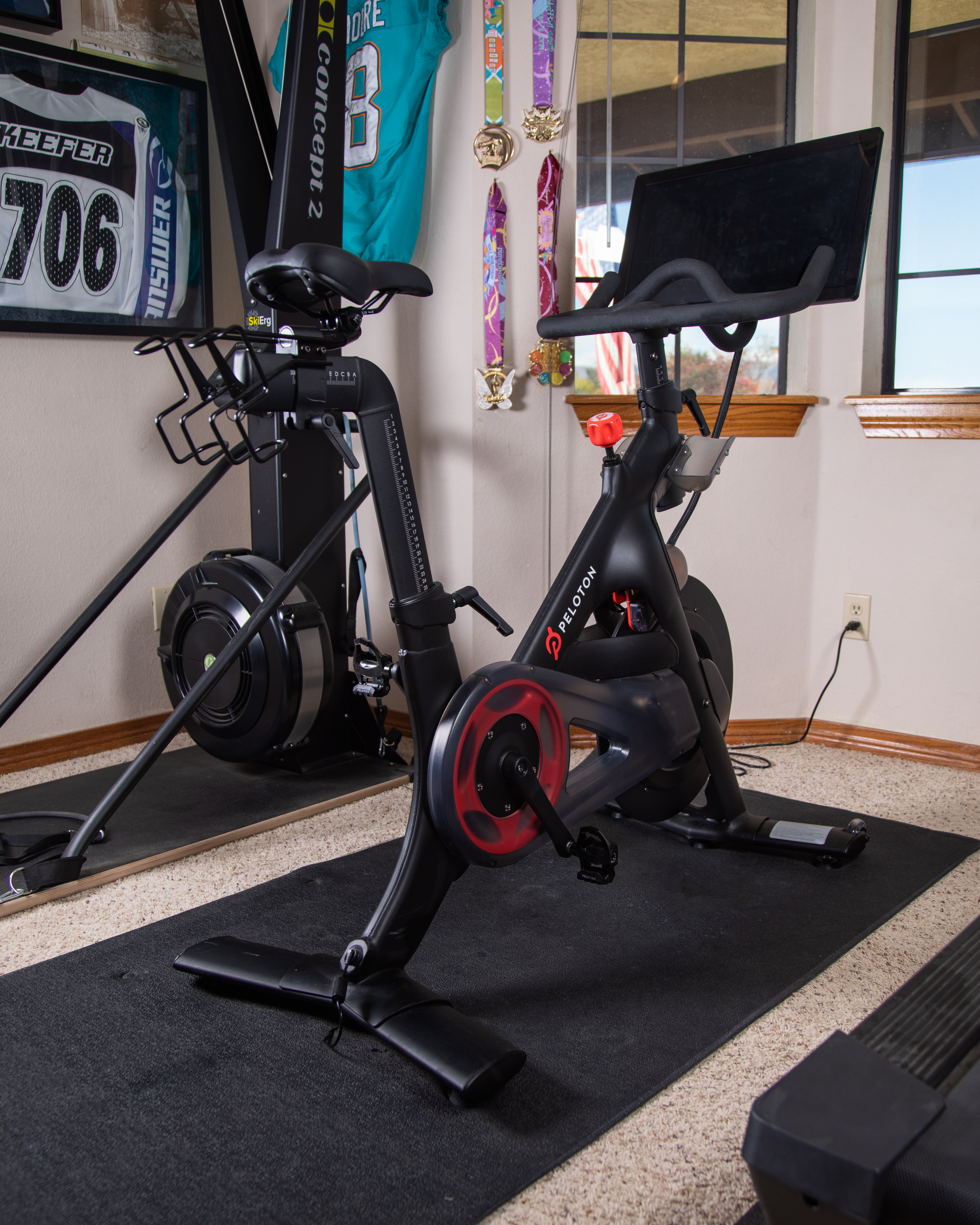We’ve had the Peloton in our household for over a year and I have always thought about doing a review for all you Moto heads out there that are maybe looking to get an in home studio spin bike. No, it’s not dirt bikes, but getting in shape to ride a dirt bike is an important aspect to staying safe and keeping your ass on your seat. I am an avid road/mountain bike cyclist, but sometimes I just want to get my workout done at home. Heather’s busy schedule doesn’t always offer her enough daylight to go on a pedal from home, so getting a spin bike was on our radar for a while. Below are some details about the bike, some of my thoughts and if it’s a viable option for the middle class active family.

In short: This thing is really cool. First, the bike itself is sleek and extremely well-built. It’s easy to adjust to fit nearly any size rider. The bike is built to safely accommodate riders between 4′11″ and 6′5″ who weigh up to 300 pounds and the smartly designed tightening handles have a secondary adjustment so they can rotate out of the way once the bolts are secure. The pedals and flywheel turn extremely smoothly and near silently, with electromagnetic resistance that is so sensitive, you can adjust it by 1% point at a time. It’s also cool that if your significant other or roommates DO NOT want to be bothered they will not hear you spinning away with your headphones in. The saddle is comfortable, as far as indoor cycles go and it adjusts both in height and depth. The handlebars have comfortable grips even when you’re sweating your ass off and they feel secure, with none of the wobbling that lesser bikes produce. The pedal clips, which are Look Delta compatible, hold the Peloton cycling shoes or other appropriate bike shoes securely and aren’t too challenging to clip and unclip (you’ll need to buy your shoes separately or Peloton offers some of their own). You can listen through the tablet’s built-in speakers or through wired or Bluetooth headphones, though we recommend the latter, as a cord could bounce and tangle during a workout. The bike takes up 4 feet by 2 feet of floor space so if you’re pressed for space this isn’t taking up that much of it.
The sweatproof, touch-sensitive tablet, which streams Peloton’s branded classes, is crisp and responsive (after an initial few seconds of buffering). During a ride, it displays all sorts of stats: ride time (elapsed and remaining); current speed; distance covered; cadence (how fast you’re pedaling, in revolutions per minute); resistance intensity (the percentage of tension of the magnet controlling the flywheel); calories burned, which is informed by your body size, effort level, and heart rate, if you’re wearing a heart-rate chest strap; and your heart rate, if applicable. I used a Garmin HR strap, from my 945 Forerunner which connected seamlessly; a Peloton-branded one ($50) is available for purchase. You’ll also see “output” or the wattage of energy you’re expending in the moment, on average, and in total, the last of which determines your place on the leaderboard. This element is what unleashes riders’ competitiveness and is the reason Peloton—and Flywheel, which was first to do this in its studio classes—is so popular, particularly among the Type A personalities or most Moto heads of the world.
During a live class, you see the leaderboard populate as riders log in, listing their chosen screen names (and profile photo, which I must say, mine is spectacular) gender, age bracket by the decade, and location. In a prerecorded on-demand class, you instead see the names of everyone who has ever taken it. As you pedal, you can watch your rank change, which can be exciting and frustrating. For my first live class, I decided that my goal would be to finish in the 50% range of about 600 people and I got worked! You can also filter your leaderboard view to see only yourself (against your personal record for that length ride, if you choose) or your age and gender bracket (my favorite), to find out how you rank among your own demographic.

You can hide metrics from view individually, and if you want to see nothing but the instructor and the class in the lit-like-a-dance-club Peloton studio, a double tap on the screen clears everything else away. All this customization may seem like overkill, but I really enjoyed being able to decide when I cared about the numbers and when I didn’t.
The instructors and genre of music of the live classes are a huge selling point for me. My favorite instructor is Jenn Sherman because she curses a little (which I like in a woman) and she gets into the music which pumps me up!
Some workouts include upper-body exercises, using light dumbbells that you can purchase separately and nestle in a rack behind the saddle, but if you fall into the no-weights-on-a-bike camp, you have plenty of options that are pedaling only, and the class descriptions will tell you what you’re in for.
Peloton broadcasts 10 to 14 live cycling classes a day (more than 90 a week) from its studio on 23rd Street in Manhattan, similar to what a busy in-person studio offers. “Encore” classes are re-aired live classes, with new live leaderboards, that fill out the schedule when actual live classes are not available.
Many Peloton rides aren’t taken live. The Peloton library consists of thousands of on-demand cycling classes, in any of 11 class types from low impact to intervals to climbing/strength (a lot of standing up on the pedals), and from five minutes (warm-up, cooldown, and intro rides) to 90 minutes in length; most are 30 or 45 minutes. You can also choose your class based on instructor, difficulty level, music genre, or “sort” (new, trending, popular, top-rated, easiest, hardest). Finally, similar to what you get with some indoor bicycles in gyms, the Peloton library also includes about a hundred timed scenic rides—immersive videos that let you virtually pedal along coastlines, through countrysides, and on city streets at your own pace. Peloton’s repertoire also includes hundreds of off-the-bike workouts in outdoor running (via audio only), yoga, strength training, cardio high-intensity interval training, bootcamp, meditation, and stretching. They are a major selling point—and a way for Peloton members to keep their full fitness strategy within the Peloton fold. All classes, cycling and other, are viewable on the bike’s built-in tablet; on a television via the Apple TV, Amazon Fire TV, and Roku; or on an iPhone or iPad or Android phone or tablet through the Peloton app.
Finally, as part of the $39-per-month Peloton membership, you gain access to the Peloton app (iOS, Android), which you can buy separately for $13 a month if you don’t own the bike. It allows you to stream the non-cycling classes and the cycling classes at the gym on an iPhone or iPad or Android phone or tablet. (You do not, however, have access to the complete suite of real-time metrics or full leaderboard involvement, which is something to consider if a bike without onboard content is of interest.) During live classes on the app, the display shows a list of app users who are currently riding and a feed announcing notifications like milestone rides; you’re also able to give a fellow rider a virtual high five and follow other people. As of late 2019, the app can be used with the Apple Watch, which will track heart rate. Connect a separate Bluetooth cadence sensor to the app to track cadence, but an output (watts) readout is not supported. We used the app on an iPad and found its organization and navigation exceptionally clear and easy; classes streamed smoothly and with few issues. The off-the-bike workouts are solid, well done, and provide additional value beyond the bike. They also make it easy to mix and match workouts to fulfill a goal or round out a workout calendar (for instance, a post-cycling stretching class or a full-body strength-training session on a non-cycling day). We also like that people who don’t own a Peloton bike may try it free for 30 days and then buy into it if they want.
Now let’s get to what is most important. That price!
The basic startup costs:
•$1,895 for the bike
•$125 for Peloton-brand cycling shoes (you will need these if you don’t have cycling shoes with Look cleats, which—if you’re not sure what you own—are big and bulky and compatible with road-style shoes only)
•$468 for yearly membership ($39/month), required for the first year. If you pay up front for one year, a thirteenth month is included, and for two years, three extra months are added.
That brings the bare-minimum total for the first year to $2,488 (plus tax, if applicable).1
Other nice-to-have extras include:
•$60 for a bike mat (recommended to protect hardwood floors)
•$50 for the heart-rate monitor
•$25 for a pair of 1-, 2-, or 3-pound dumbbells for the upper-body exercises
So if you’re already a boutique-cycling enthusiast, like my wife Heather, where do you break even? By Heather’s math, the Peloton “pays for itself” in about five months if you’re someone who is committed to taking about four classes a week at an elite studio.
Peloton offers a 30-day home trial option: delivery and professional installation of the bike followed by a trial period for up to 30 days from the delivery date. If you’re not sold, Peloton will pick up the bike and issue a refund. You are, of course, required to pay for the bike in full up front or, if financing, pay the first installment.

The other big flaw and potential dealbreaker:
Without that monthly membership, the bike’s functionality is seriously limited. The Peloton library, which houses thousands of classes—the company says it produces nearly a thousand original workouts a month across its fitness categories—is reduced to just three 45-minute ones. You also get a basic “ride” mode (sans the scenic vistas) that allows you to pedal and adjust resistance at your own whim. And while you do see real-time stats during your rides, neither the classes nor the free-ride option includes a leaderboard or even your own personal best to compete against, and there’s no way to save a record of your ride beyond snapping a smartphone photo of the screen the moment you complete it. The company does allow a membership freeze of up to three months in your first year if, say, you get injured or your wife is pregnant or go on an extended vacation, and you may freeze it for as long as you like after the first year. You just don’t get much from the bike if you do so.
And since the tablet is a connected device, there’s nothing stopping Peloton from pushing a software update that even further limits the bike’s offline usability at any point in the future. It’s tempting to think of devices like the Peloton as appliances. But when they are hooked to a network and reliant on software updates, you have no guarantee they will function forever as they do now.
Another potential annoyance is that you can’t pause any of the rides, either live or on-demand—if you have to get up, they keep running without you. One of the reasons to even have an expensive spin bike at home is that if something comes up—the phone rings, the kids need something, the dog (like our dog Oreo) gets too close to your flywheel for comfort, there’s a knock at the door—you should be able to jump off for a minute or two and come back to pick up where you left off. Instead, your ride continues regardless. You can rejoin it in progress, or (with on-demand rides) you have the option to start over again from the top. Other large, expensive gym equipment offers at least a short pause function.
The handlebar height can be tough to adjust, as the attached tablet is very heavy. That said, handlebar height is more of a preference than an adjustment need for fit, so you may be able to get away with one height for all the riders who use your bike.
At the end of the day the Peloton is a great tool to get in shape at home. Maybe it’s not the “cool” thing to do if you’re a pro, but to me if you want to get in better shape and can’t always make it outside to bicycle, this bike has a lot of features that keeps me entertained while hitting different muscles that don’t normally get worked on a “normal” pedal bike. If you’re not able to get outside and ride a bicycle due to the weather, or during quarantine, have limited amounts of time during the day, this in home studio bicycle is a great buy. I wasn’t on board when Mrs. Keefer wanted one, but now that we have it, I really like the variation it brings to my regular scheduled workouts. Did I mention there were hot women? If I didn’t let me say it again! Oh and if you’re a woman looking for hot dudes, I guess there are those too!
Any questions about this review or the Peloton give me a jingle at kris@keeferinctesting.com





